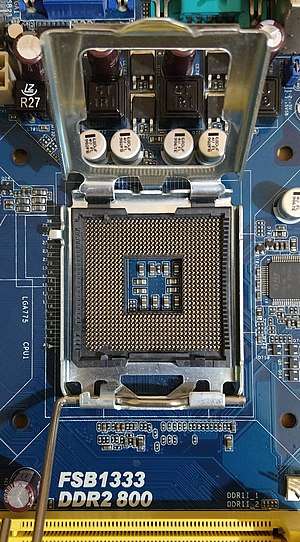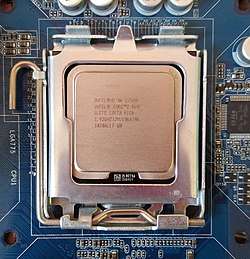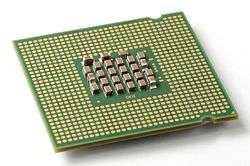LGA 775
LGA 775, also known as Socket T, is an Intel desktop CPU socket. LGA stands for Land Grid Array. Unlike earlier common CPU sockets, such as its predecessor Socket 478, the LGA 775 has no socket holes; instead, it has 775 protruding pins which touch contact points on the underside of the processor (CPU).[2]
 | |
| Type | LGA |
|---|---|
| Chip form factors | Flip-chip land grid array |
| Contacts | 775 |
| FSB protocol | AGTL+ |
| FSB frequency | 133 MHz (533 MT/s) 200 MHz (800 MT/s) 266 MHz (1066 MT/s) 333 MHz (1333 MT/s) 400 MHz (1600 MT/s) |
| Processor dimensions | 1.47 × 1.47 inches (37.5mm)[1] |
| Processors | Intel Pentium 4 (2.60 - 3.80 GHz) Intel Celeron D (2.53 - 3.60 GHz) Intel Pentium 4 Extreme Edition (3.20 - 3.73 GHz) Intel Pentium D (2.66 - 3.60 GHz) Pentium Extreme Edition (3.20 - 3.73 GHz) Pentium Dual-Core (1.40 - 3.33 GHz) Intel Core 2 Duo (1.60 - 3.33 GHz) Intel Core 2 Quad (2.33 - 3.00 GHz) Intel Core 2 Extreme (2.66 - 3.20 GHz) Intel Xeon (1.86-3.40 GHz) Intel Celeron (1.60 - 2.40 GHz) |
| Predecessor | Socket 478 |
| Successor | LGA 1156 (desktops and low-end servers) LGA 1366 (high-end desktops and some low-end servers) |
This article is part of the CPU socket series | |
The socket had an unusually long life span, lasting 7 years until the last processors supporting it ceased production in 2011.
The socket was superseded by the LGA 1156 (Socket H) and LGA 1366 (Socket B) sockets.
PLGA775 processors
(some of the processors listed here might not work on newer Intel based chipsets)
- Pentium 4
- Pentium 4 HT
- Pentium 4 HT Extreme Edition
- Pentium D
- Celeron / Celeron D
- Pentium Dual Core
- Pentium Extreme Edition
Heatsink Design
For LGA 775, the distance between the screw-holes for the heatsink is 72 mm. Such heat-sinks are not interchangeable with heatsinks for sockets that have a distance of 75 mm, such as LGA 1156, 1155, 1150, 1151.
Chipsets
Intel
Pentium 4 chipsets
- i845GV
- GE
- i848P
- i865G
- GV
- P / PE
- i910GL
- i915G
- GL / GV
- P / PL
- i925X / XE
Core 2 Chipsets
Lakeport: 945PL / 945P / 945G / 945GC / 945GZ / 955X / 946PL / 946GZ P
Broadwater: i955X / i946 / 946GZ / PL / 965 / i975 / Q965 / P965 / G965 / Q963 / i975X
Bearlake: X35 / P35 / Q35 / G35 / P33 / G33 / Q33 / P31 / G31 / X38
Eaglelake: X48 / P45 / P43 / G45 / G43 / G41 / B43 / Q43 / Q45
VIA
PT800 / PM800 / PT880 / PM880 / P4M800 / P4M800 Pro / PT880 Pro / PT880 Ultra / PT894 / PT894 Pro / P4M890 / PT890 / P4M900
PT880 Pro also supports AGP and PCI-Express at the same time, but only one port can be used at a time.
ATI
ATI Radeon Xpress 200 / ATI Radeon Xpress 1250 / ATI CrossFire Xpress 3200
NVIDIA
nForce4 Ultra; nForce4 SLI XE; nForce4 SLI; nForce4 SLI X16; nForce 570 SLI; nForce 590 SLI; nForce 610i; nForce 630i; nForce 650i Ultra; nForce 650i SLI; nForce 680i LT SLI; nForce 680i SLI; nForce 730i; nForce 740i SLI; nForce 750i SLI; nForce 760i SLI; nForce 780i SLI; nForce 790i SLI; GeForce 9300; GeForce 9400
Sources:[3]
LGA 775 was the last Intel socket for desktops, for which third-party companies manufactured chipsets. Nvidia was the last third-party manufacturer of LGA 775 chipsets (its final product was MCP7A family, marketed as GeForce 9300/9400, launched in October 2008), as other third-parties discontinued their products earlier. All chipsets for superseding sockets were exclusively designed and manufactured by Intel, a practice later also adopted by AMD when they first launched APUs in 2011 (Socket AM3+ processors, also first launched in 2011, were usually paired with AMD chipsets, but some motherboards using third-party chipsets were also manufactured, usually with Nvidia chipsets, as Socket AM3+ design directly derived from earlier Socket AM3 design).
Improvements in heat dissipation

The force from the load plate ensures that the processor is completely level, giving the CPU's upper surface optimal contact with the heat sink or cold-water block fixed onto the top of the CPU to carry away the heat generated by the CPU. This socket also introduces a new method of connecting the heat dissipation interface to the chip surface and motherboard. With LGA 775, the heat dissipation interface is connected directly to the motherboard on four points, compared with the two connections of the Socket 370 and the "clamshell" four-point connection of the Socket 478.
This was done to avoid the reputed danger of the heat sinks/fans of pre-built computers falling off in transit. LGA 775 was announced to have better heat dissipation properties than the Socket 478 it was designed to replace, but the Prescott core CPUs (in their early incarnations) ran much hotter than the previous Northwood-core Pentium 4 CPUs, and this initially neutralized the benefits of better heat transfer.
However, modern Core 2 processors run at much lower temperatures than the Prescott CPUs they replaced.
Processors with lower TDP and clock speeds only used Thermal Interface Compound in between the die and the integrated heat spreader (IHS), while processors with higher TDP and clock speeds wave the die soldered directly to the IHS, allowing for better heat transfer between the CPU and the integrated heat spreader.
LGA 775 Mechanical load limits
All LGA 775 processors have the following mechanical maximum load limits which should not be exceeded during heat sink assembly, shipping conditions, or standard use. Load above those limits could crack the processor die and make it unusable.
| Location | Dynamic | Static |
|---|---|---|
| IHS Surface | 756 N (170 lbf) (77 kp) | 311 N (70 lbf) (31 kp) |
The transition to the LGA packaging has lowered those load limits, which are smaller than the load limits of Socket 478 processors but they are bigger than Socket 370, Socket 423 and Socket A processors, which were fragile. They are large enough to ensure that processors will not crack.
LGA 775 compatibility
Compatibility is quite variable, as earlier chipsets (Intel 915 and below) tend to support only single core NetBurst Pentium 4 and Celeron CPUs at an FSB of 533/800 MT/s.
Intermediate chipsets (e.g. Intel 945) commonly support both single core Pentium 4-based CPUs as well as dual core Pentium D processors. Some motherboards using the 945 chipset could be given a BIOS upgrade to support 65nm Core-based processors. Other chipsets have varying levels of CPU support, generally following the release of contemporary CPUs, as LGA 775 CPU support is a complicated mixture of chipset capability, voltage regulator limitations and BIOS support. For example, the newer Q45 chipset does not support NetBurst-based CPUs such as the Pentium 4, Pentium D, Pentium Extreme Edition, and Celeron D.
Virtualization Capabilities
Core 2 and other LGA 775 processors are capable of doing Virtualization but only requires using VMware Workstation 12 (or other equivalents) and it is not compatible with new versions of VMware Workstation. This was because of Intel VT-x with EPT (Extended Page Table) or simply known as SLAT (Second-level address translation) lacks on the processors . Intel's VT-x with EPT was introduced on the newer, Nehalem micro-architecture.
To check if you processor is capable for VM, click here. Recommended Requirements for VM
- A Pentium Processor E-Series or A Core 2 Processor
- (Dual Core or Quad-Core) 2 GHz or higher
- VMWare Workstation 9 or VMWare Player 7[4]
- 1 GB of Video RAM (Great for single Virtual Machine)
- 4 GB+ of Video RAM is only necessary if running multiple instance of VMs
- 2 GB of RAM or higher (Higher Memory means more performance.)
- A Motherboard and BIOS that supports Intel VT-x
Sample Specs
ECS G31T-M7 Rev.1 or Rev.7 Motherboard ( G31 Express Chipset )
GeForce GT 520
4GB DDR2-800Mhz
Core 2 Duo E8400
SSD - Windows 10 Pro
Important : Using Single Core for a Pentium 4 or a Virtual Machine might not deliver full performance.
See also
References
- "Intel Pentium 4 Datasheet" (PDF). Archived from the original (PDF) on February 24, 2008.
- "New P4 Socket Type LGA 775 (Socket T)". asisupport.com. Archived from the original on December 13, 2007. Retrieved 2007-03-14.
- "ASRock > Motherboard Series". ASRock. Archived from the original on 15 March 2015. Retrieved 15 March 2015.
- "Download VMware Player 7 here".
External links

